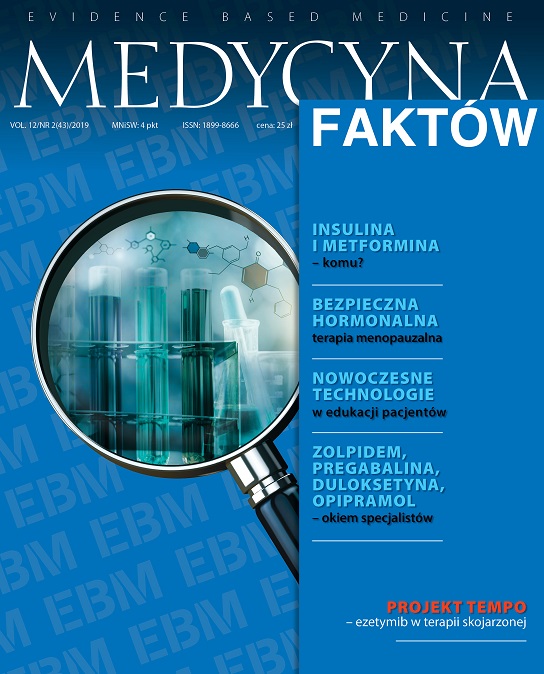The need to consider sex as a decisive factor in choosing an anti-epileptic medicine. The most frequently asked questions and doubts Review article
Main Article Content
Abstract
The treatment of epilepsy of men, especially in certain periods of life, is fundamentally different than in women. For example, medicines that can be used in men without risk, cannot be used in young girls or women in childbearing age. The paper presents guidelines on the individualization of anti-epileptic treatment depending on sex.
Article Details
How to Cite
Błaszczyk , B. (2016). The need to consider sex as a decisive factor in choosing an anti-epileptic medicine. The most frequently asked questions and doubts. Medycyna Faktow (J EBM), 12(2(43), 109-114. https://doi.org/10.24292/01.MF.0219.4
Issue
Section
Articles
Copyright © by Medical Education. All rights reserved.
References
1. Rejdak K., Rola R., Mazurkiewicz-Bełdzińska M. et al.: Diagnostyka i leczenie padaczki u osób dorosłych – rekomendacje Polskiego Towarzystwa Neurologicznego. Pol. Przegl. Neurol. 2016; 12(1): 15-27.
2. Svalheim S., Sveberg L., Mochol M., Tauboll E.: Interactions between antiepileptic drugs and hormones. Seizure 2015; 28: 12-17.
3. Shih F.Y. Chuang Y.C., Chuang M.J. et al.: Effects of antiepileptic drugs on thyroid hormone function in epilepsy patients. Seizure 2017; 48: 7-10.
4. Kwan P., Brodie M.: Early identification of refractory epilepsy. N. Engl. J. Med. 2000; 342: 314-319.
5. Brodie M., Barry S.J.E., Bamagous G.A. et al.: Patters of treatment response in newly diagnosed epilepsy. Neurology 2012; 78: 1548-1554.
6. Chen Z., Brodie M.J., Liew D., Kwan P.: Treatment outcomes in patients with newly diagnosed epilepsy treated with established and new antiepileptic drugs: a 30-year longitudinal cohort study. JAMA Neurol. 2018; 75: 279-286.
7. Perucca E., Gilliam F.G.: Adverse effects of antiepileptic drugs. Lancet Neurol. 2012; 11(9): 792-802.
8. Kanner A.M., Ashman E., Gloss D. et al.: Practice guideline update summary: Efficacy and tolerability of the new antiepileptic drugs. Treatment of the new-onset epilepsy. Neurology 2018; 91: 74-81.
9. Luef G., Kramer G., Stefan H.: Oxcarbazepine treatment in male epilepsy patients. Acta Neurol. Scand. 2009; 119: 94-99.
10. Luef G.J.: Epilepsy and sexuality. Seizure 2008; 17(2): 127-130.
11. Nishimura T., Sakai M., Yonezawa H.: Effects of valproic acid on fertility and reproductive organs in male rats. J. Toxicol. Sci. 2000; 25: 85-93.
12. Isojärvi J.: Disorders of reproduction in patients with epilepsy: Antiepileptic drug related mechanisms. Seizure 2008; 17: 111-119.
13. Jędrzejczak J., Bomba-Opoń D., Jakiel G. et al.: Postępowanie z kobietą z padaczką w okresie rozrodczym. Rekomendacje Polskiego Towarzystwa Epileptologii i Polskiego Towarzystwa Ginekologicznego. Ginekologia i Perinatologia Praktyczna 2017; 2(3): 108-119.
14. Tomson T., Xue H., Battino D.: Major congenital malformations in children of women with epilepsy. Seizure 2015; 28: 46-50.
15. Vajda F.J.E.: Effect of antiepileptic drug therapy on the unborn child. J. Clin. Neurosc. 2014; 21: 716-721.
16. Meier C., Kraenzlin M.E.: Antiepileptics and Bone Health. Ther. Adv. Musculoskelet. Dis. 2011; 3(5): 235-243.
17. Miziak B., Błaszczyk B., Chrościńska-Krawczyk M. et al.: The problem of osteoporosis in epileptic patients taking antiepileptic drug. Expert Opin. Drug Saf. 2014; 13(7): 935-946.
2. Svalheim S., Sveberg L., Mochol M., Tauboll E.: Interactions between antiepileptic drugs and hormones. Seizure 2015; 28: 12-17.
3. Shih F.Y. Chuang Y.C., Chuang M.J. et al.: Effects of antiepileptic drugs on thyroid hormone function in epilepsy patients. Seizure 2017; 48: 7-10.
4. Kwan P., Brodie M.: Early identification of refractory epilepsy. N. Engl. J. Med. 2000; 342: 314-319.
5. Brodie M., Barry S.J.E., Bamagous G.A. et al.: Patters of treatment response in newly diagnosed epilepsy. Neurology 2012; 78: 1548-1554.
6. Chen Z., Brodie M.J., Liew D., Kwan P.: Treatment outcomes in patients with newly diagnosed epilepsy treated with established and new antiepileptic drugs: a 30-year longitudinal cohort study. JAMA Neurol. 2018; 75: 279-286.
7. Perucca E., Gilliam F.G.: Adverse effects of antiepileptic drugs. Lancet Neurol. 2012; 11(9): 792-802.
8. Kanner A.M., Ashman E., Gloss D. et al.: Practice guideline update summary: Efficacy and tolerability of the new antiepileptic drugs. Treatment of the new-onset epilepsy. Neurology 2018; 91: 74-81.
9. Luef G., Kramer G., Stefan H.: Oxcarbazepine treatment in male epilepsy patients. Acta Neurol. Scand. 2009; 119: 94-99.
10. Luef G.J.: Epilepsy and sexuality. Seizure 2008; 17(2): 127-130.
11. Nishimura T., Sakai M., Yonezawa H.: Effects of valproic acid on fertility and reproductive organs in male rats. J. Toxicol. Sci. 2000; 25: 85-93.
12. Isojärvi J.: Disorders of reproduction in patients with epilepsy: Antiepileptic drug related mechanisms. Seizure 2008; 17: 111-119.
13. Jędrzejczak J., Bomba-Opoń D., Jakiel G. et al.: Postępowanie z kobietą z padaczką w okresie rozrodczym. Rekomendacje Polskiego Towarzystwa Epileptologii i Polskiego Towarzystwa Ginekologicznego. Ginekologia i Perinatologia Praktyczna 2017; 2(3): 108-119.
14. Tomson T., Xue H., Battino D.: Major congenital malformations in children of women with epilepsy. Seizure 2015; 28: 46-50.
15. Vajda F.J.E.: Effect of antiepileptic drug therapy on the unborn child. J. Clin. Neurosc. 2014; 21: 716-721.
16. Meier C., Kraenzlin M.E.: Antiepileptics and Bone Health. Ther. Adv. Musculoskelet. Dis. 2011; 3(5): 235-243.
17. Miziak B., Błaszczyk B., Chrościńska-Krawczyk M. et al.: The problem of osteoporosis in epileptic patients taking antiepileptic drug. Expert Opin. Drug Saf. 2014; 13(7): 935-946.

